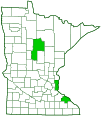shaved horse fly
(Stonemyia rasa)
Conservation • Description • Habitat • Ecology • Distribution • Taxonomy
Conservation Status |
|
|||||||
| IUCN Red List | not listed |
|||||||
| NatureServe | N5 - Secure |
|||||||
| Minnesota | not listed |
|||||||
Description |
||
Shaved horse fly is a small horse fly. It occurs on the northern United States from Maine to Minnesota, south to Illinois and North Carolina, and in Ontario. It is uncommon in Minnesota, where it is at the western extent of its range. Adults are stout-bodied and 7 ⁄16″ to ½″ (11 to 13 mm) in length. There are two large compound eyes on the side of the head and three simple eyes (ocelli) in a triangle at the top of the head (vertex). On the male the compound eyes meet at the top of the head. On the female they do not. The inner upper corner of the compound eye on the female forms a right angle. The antennae have three segments, the scape, the pedicel, and the flagellum. The scape is only slightly longer than wide, the pedicel is much shorter than wide, and the flagellum has many ring-like segments (annulated). The abdomen is black. The sides are sometimes pale but are never orange. The rear margin of each segment has a fringe of grayish hairs that sometimes expands into a triangle in the middle. The first segment is deeply notched at the middle of the hind margin. The wing is clear and faintly tinted. It does not have dark markings and is not darkened at the base or at the tip. The cell at the leading edge (costal cell) is clear. At the base of each wing there are two small, rounded lobes (calypters) that cover the halteres. The calypters are large and unequal in size. The legs are reddish-brown to dark brown. The fourth segment (tibia) of the hind legs have large spurs at the tip. The last part of the foot (tarsus), corresponding to the foot, has three pads. |
||
Size |
||
Total length: 7 ⁄16″ to ½″ (11 to 13 mm) |
||
Similar Species |
||
Habitat |
||
|
||
Ecology |
||
Season |
||
Late July to September |
||
Behavior |
||
|
||
Life Cycle |
||
|
||
Larva Food |
||
|
||
Adult Food |
||
Females feed on mammalian blood. Males feed on flower nectar. |
||
Distribution |
||||
|
Sources |
|||
| 2/8/2023 | ||||
Occurrence |
||||
|
||||
Taxonomy |
|||
Order |
Diptera (Flies) | ||
Suborder |
Brachycera | ||
Infraorder |
Orthorrhapha | ||
Parvorder |
Tabanomorpha (snipe flies and allies) |
||
Superfamily |
Tabanoidea | ||
Family |
Tabanidae (horse and deer flies) | ||
Subfamily |
Pangoniinae (long-tongue horse flies) | ||
Tribe |
Pangoniini | ||
Genus |
Stonemyia | ||
Synonyms |
|||
Pangonia rasa |
|||
Common Names |
|||
shaved horse fly |
|||
Glossary
Calypter
On flies: one of two small membranous lobes at the base of the forewing that covers the haltere.
Costa
On plants: The central axis of a pinna, to which pinnules are attached. On insects: The vein on the leading edge of the forewing.
Ocellus
Simple eye; an eye with a single lens. Plural: ocelli.
Scape
In plants: An erect, leafless stalk growing from the rootstock and supporting a flower or a flower cluster. In insects: The basal segment of the antenna.
Tarsus
On insects, the last two to five subdivisions of the leg, attached to the tibia; the foot. On spiders, the last segment of the leg. Plural: tarsi.
Tibia
The fourth segment of an insect leg, after the femur and before the tarsus (foot). The fifth segment of a spider leg or palp. Plural: tibiae.
Visitor Photos |
|||||
Share your photo of this insect. |
|||||
| This button not working for you? Simply email us at info@MinnesotaSeasons.com. Attach one or more photos and, if you like, a caption. |
|||||
Alfredo Colon |
|||||
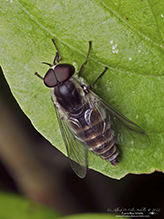 |
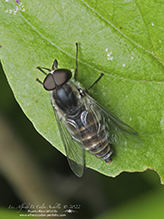 |
||||
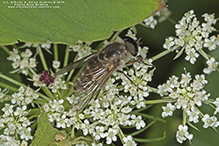 |
|||||
Luciearl |
|||||
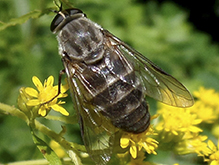 |
|||||
MinnesotaSeasons.com Photos |
|||||
|
|||||

Slideshows |
||

Visitor Videos |
|||
Share your video of this insect. |
|||
| This button not working for you? Simply email us at info@MinnesotaSeasons.com. Attach a video, a YouTube link, or a cloud storage link. |
|||
Other Videos |
|||


Created: 9/5/2019
Last Updated:
